twister6
Android Expert
This is a Review of AudioQuest Dragonfly USB DAC v1.2. http://www.audioquest.com/usb_digital_analog_converter/dragonfly-dac , also available on Amazon: http://www.amazon.com/AUDIOQUEST-DRAGONFLY-V1-2-USB-DAC/dp/B00H00VLZQ/?tag=vectron00-20
No matter how much I enjoy listening to music from a portable DAP or a smartphone, laptop is still a very important part of my personal entertainment, and I'm not giving up on it especially since nothing can substitute for me a physical keyboard! Unfortunately, my laptop audio performance is subpar which becomes painfully noticeable whenever I use premium headphones trying to play higher res audio. It's a common problem recognized by a number of manufacturers with their own USB DAC/amp solutions in a form of a small external usb device used like an external audio card. In the past few months I had an opportunity to review a number of such products, but after every review I have been asked to compare it to Dragonfly - a portable device that started its journey almost 3 years ago and paved a way for a lot of other similar products. Now, over a year after their hardware update to v1.2, I got an opportunity to review this friendly insect and would like to share with you about its infectious soundbite!
Starting with a packaging, the first thing you notice is a colorful image of dragonfly on the cover. I typically don’t analyze a product name since often it’s a boring mixture of letters and number, but I actually found it here to be rather unique. Furthermore, I think it was brilliant how their projected this image even further by having a custom shaped “dragonfly” led with changing colors corresponding to a sample rate (more about it later). I found a read around the box to be quite educational to learn about the product description, capabilities and features. Basically, you can familiarize yourself with DragonFly USB DAC even before taking it out.
Out of the box, you will find a dense foam tray with a cutout for the Dragonfly DAC and the included leather case. Typically I would find a case for usb-stick size device to be an add-on filler, but here it looked and felt like a premium accessory which I’m definitely planning to use moving forward with this USB DAC. I know, this is only a small pocket case, but the level of details with a neat stitching around it and stamped dragonfly logo with a model and a company name was very impressive. Plus, it will protect soft touch finish of the DAC when not in use. Another must-have accessory worth mentioning is DragonTail 4” usb extender. This is NOT included with DragonFly and has to be purchased separately, but I really hope that moving forward AudioQuest will consider adding it as a bonus with their DAC (considering competitive pricing of other similar products).
DragonTail is not just an accessory for convenience. DragonFly itself comes with a built-in full size usb connector (covered with protective dust cap) which requires you plugging it into your laptop/PC/Mac, etc. Often due to adjacent usb ports or location on the back, it’s not always convenient to have a device plugged in directly, so extension helps mitigate this problem. At the same time you have to remember that AudioQuest is a well known company that also makes top quality digital and audio cables. A cable is a conductor with multiple wires where a proper isolation of power and data lines while keeping it further away from a noisy motherboard of your laptop will improve signal integrity and EMI interference. The effect could be subtle, but keep in mind there is a good reason why bringing out audio digitally from your laptop to process analog part externally yields cleaner audio signal. Thus, I would strongly recommend getting DragonTail as an accessory to DragonFly. Plus, if not paying attention, it’s easy to disengage DragonFly by accident from your host usb socket if you pull on headphone chord by mistake. With USB extension cable you have more flexibility if you pull on a chord by accident.
Unboxing and accessories.
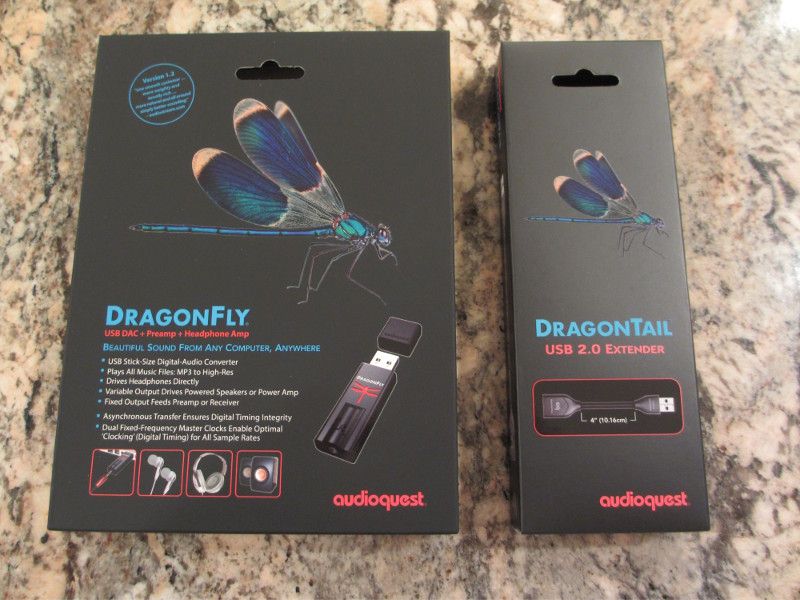
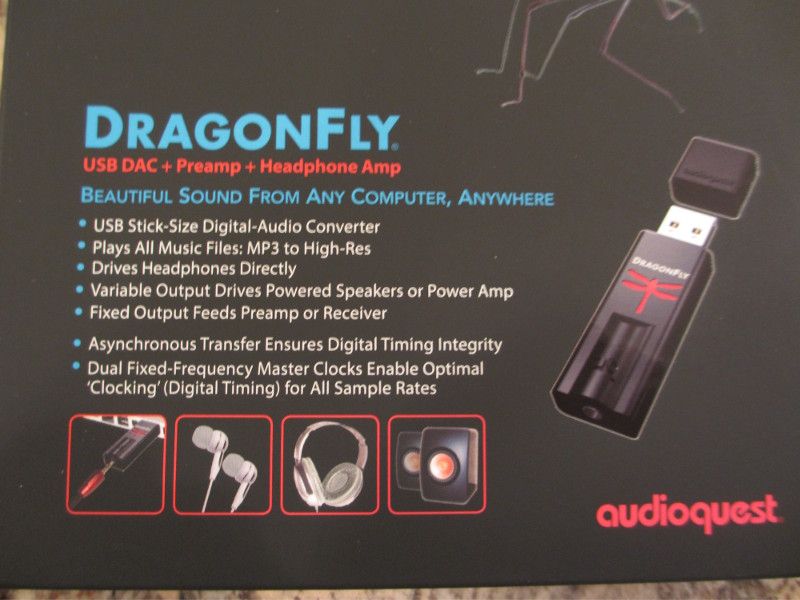
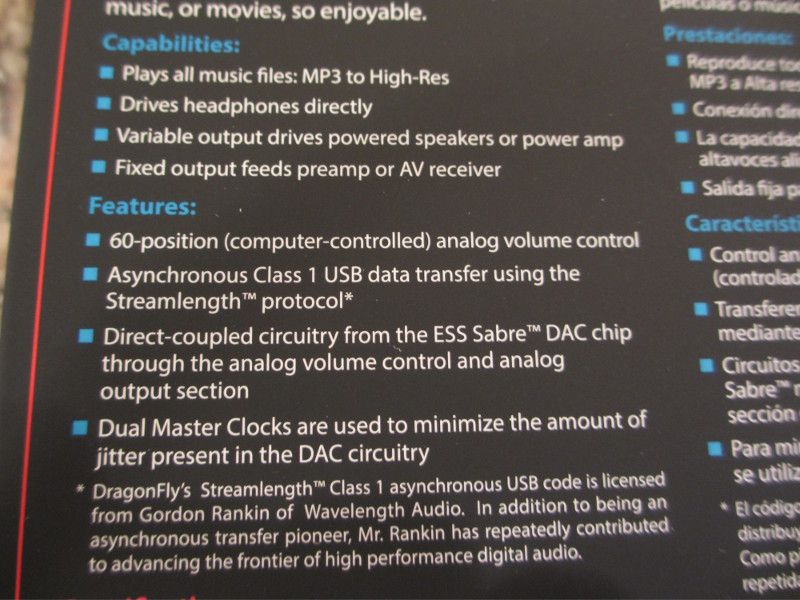
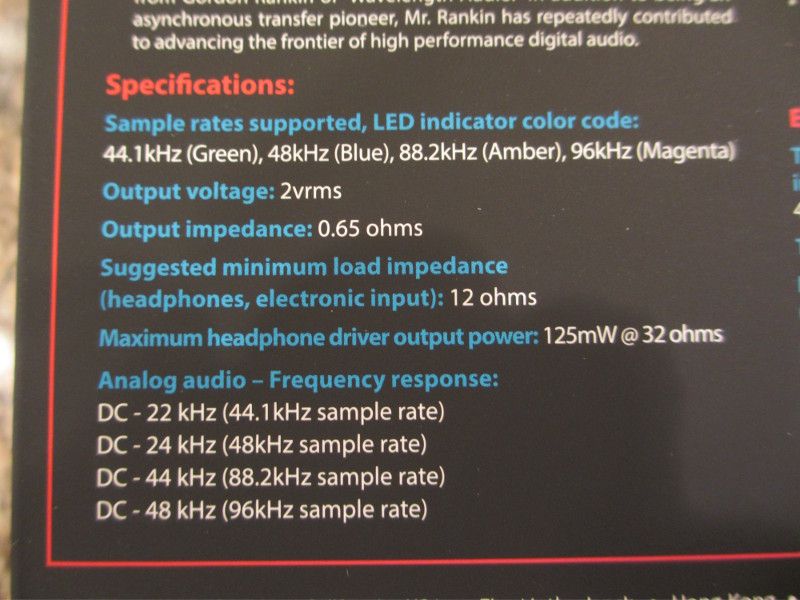
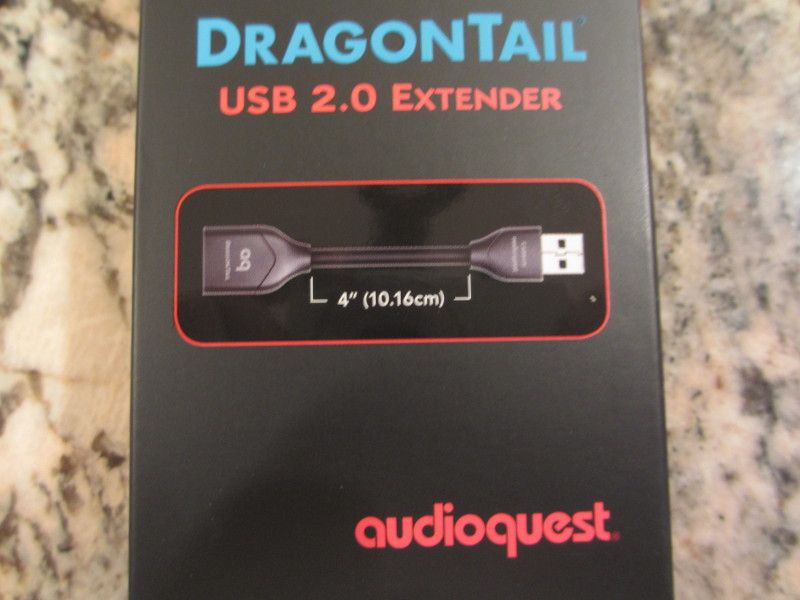
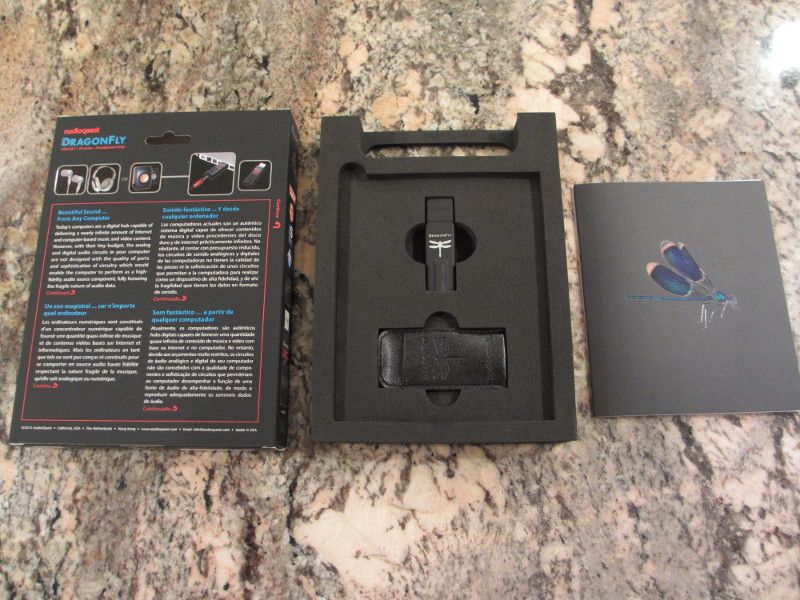
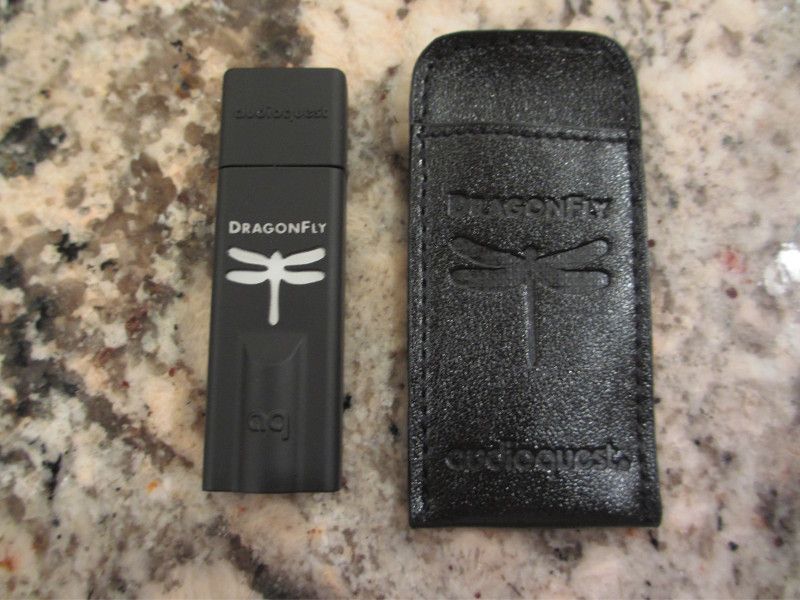
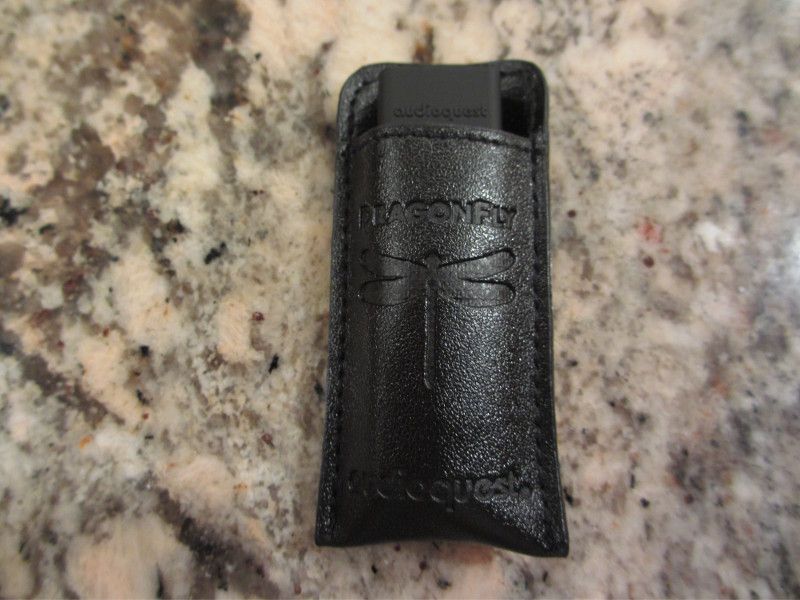
The first impression you get when holding DragonFly in your hand is how much it resembles an ordinary USB stick. It has very similar dimensions with full size usb connector on one end (and a traditional dust cap), and 3.5mm headphone jack on the other end. The build is very solid and has a little bit of weight to it, definitely feels sturdy. By feeling a slightly colder surface, I'm pretty sure the shell is made out of aluminum or some lightweight alloy, and it has a soft touch rubbery finish similar to ThinkPad laptops (perfect match for me since I only use ThinkPads). Also, right in the middle of the module there is an emblem of a dragonfly with DragonFly name above it. What is really cool, the emblem is a hidden led in a shape of a dragonfly that lights up in different colors to reflect sample rate of your source: 44.1kHz (green), 48kHz (blue), 88.2kHz (amber), 96kHz (magenta).
Design details.
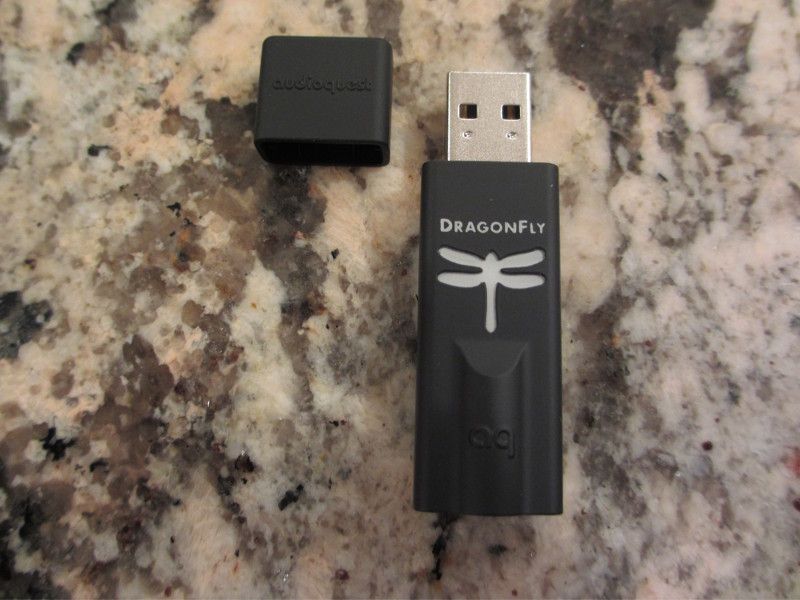
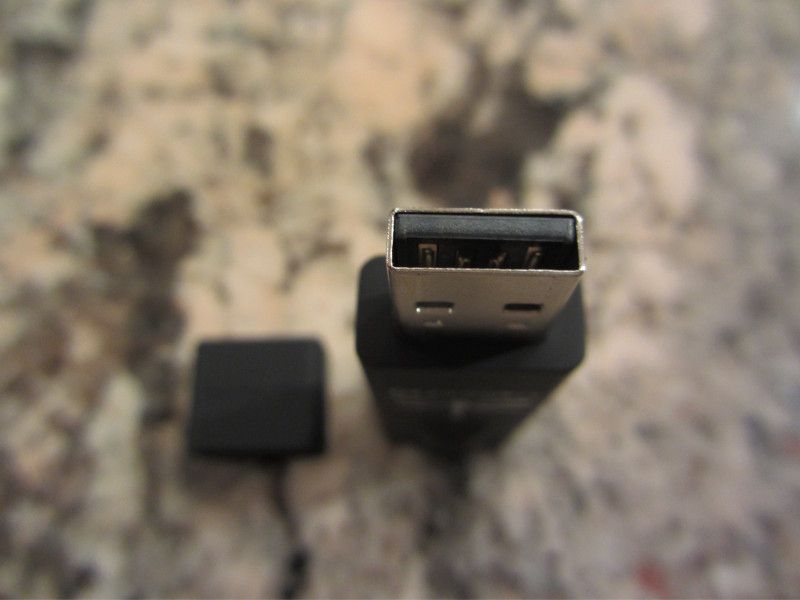
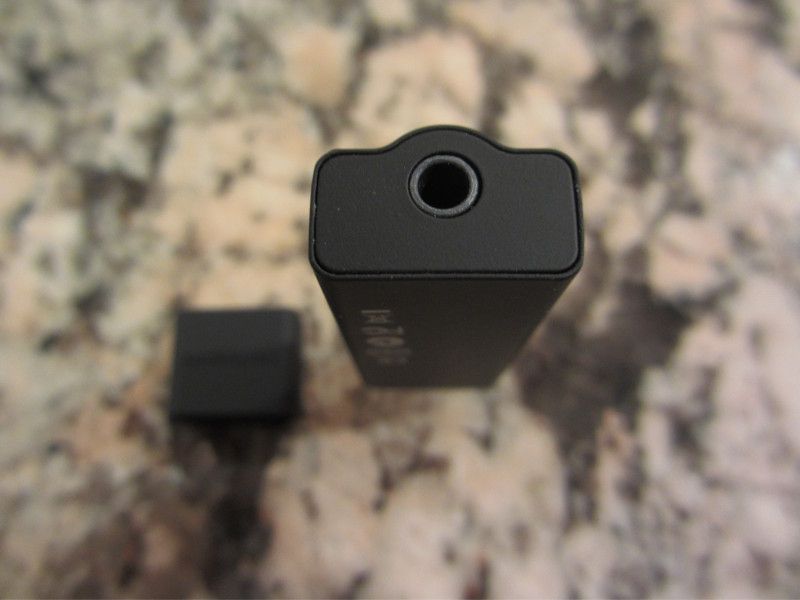
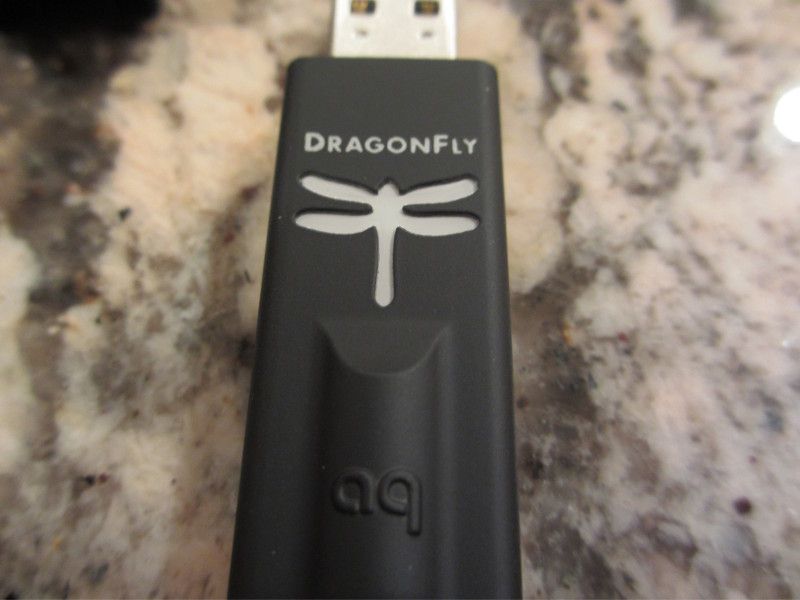
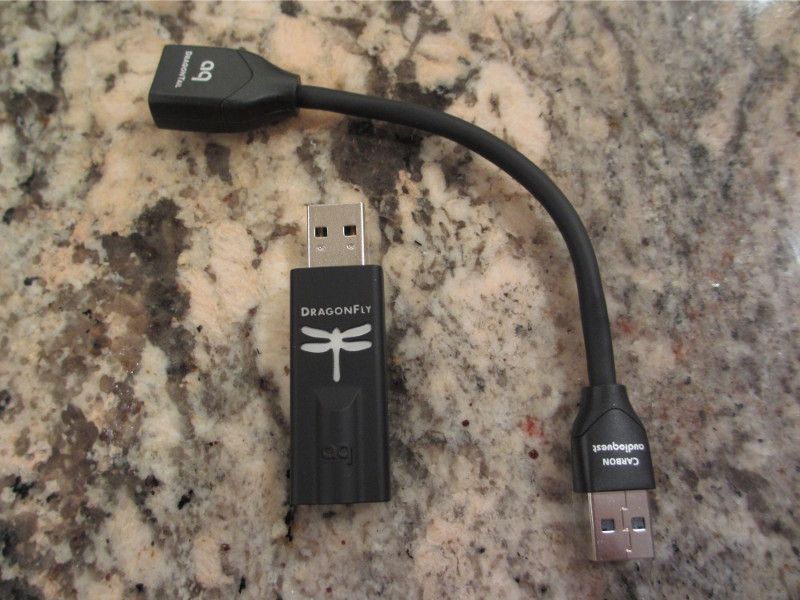
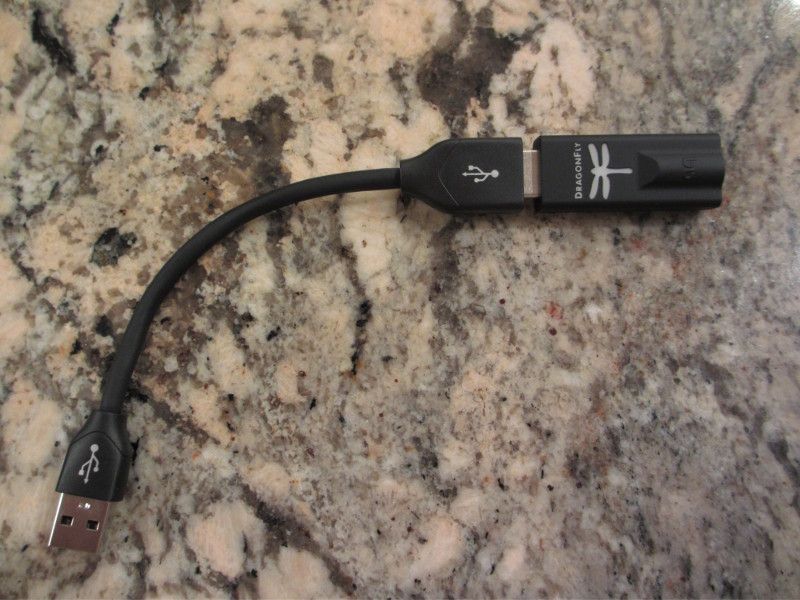
One might wonder, what can you possibly pack inside of such a small footprint? Well, apparently you can stuff it with ESS Sabre DAC, analog volume control (controlled through computer with 60-position resolution), and analog output buffer section. Furthermore, it supports asynchronous Class 1 USB data transfer using some proprietary protocol which enhances performance of digital audio. Personally, I prefer to make my final judgment of a sound quality based on what I hear with my own ears rather than fancy design terminology, but I was still impressed that AudioQuest provided details of the design unlike some other companies that prefer to keep it as a "black box".
Connection to my laptop was flawless, and after initial "pair up" of installing/checking all the necessary Windows drivers, it worked in a true instantaneous plug'n'play fashion with the last volume setting being recalled upon each plug in. I don't have any high impedance headphones to confirm, but with most of my IEMs and headphones I didn't have to raise volume higher than 1/4 of the way, but you can pump it pretty loud with a linear performance and no distortion. One unique feature of DragonFly is that you can enjoy variable volume output while adjusting the level through your audio player and/or computer system. But once you set the output of both audio player and computer to a maximum level, you can feed it directly to external portable amp or desktop preamp/AV receiver. It wasn't clear to me if internal amp gets disabled at maximum volume output, acting like a typical LO, but I assume the intention of that was to avoid double amping.
Connected to laptop.
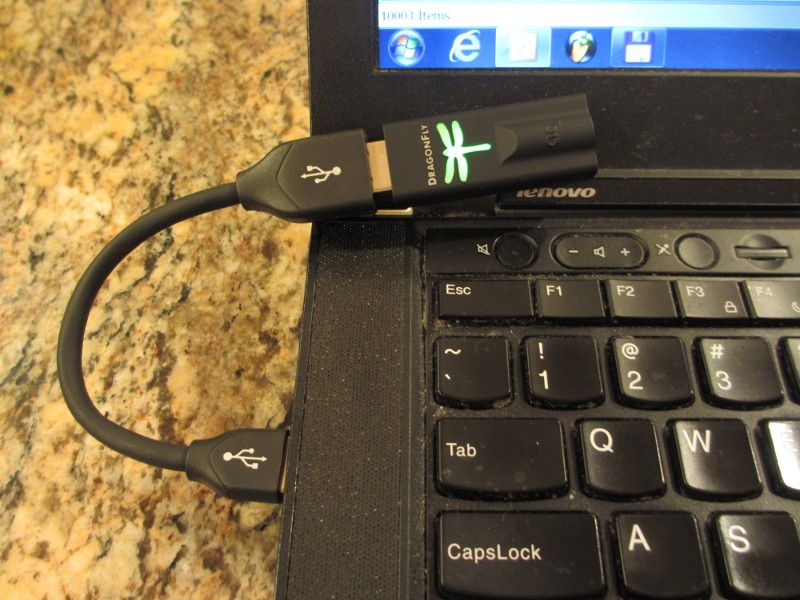
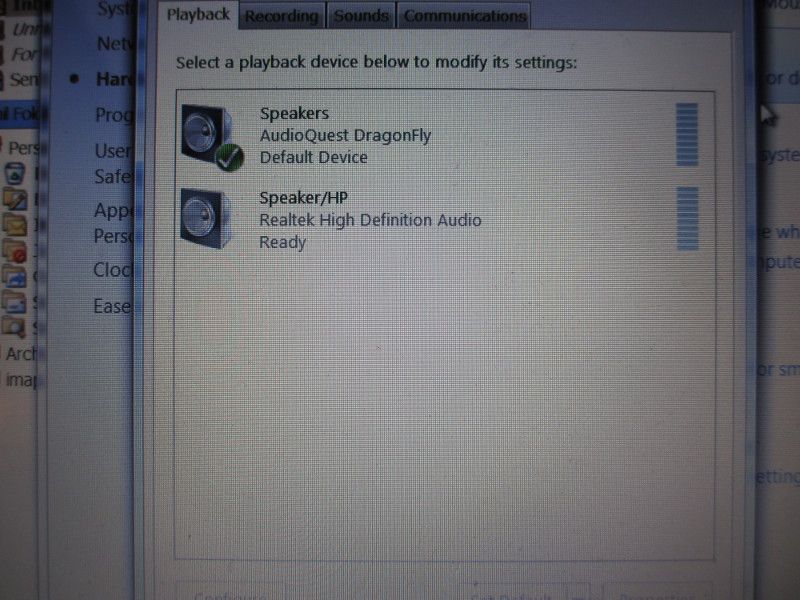
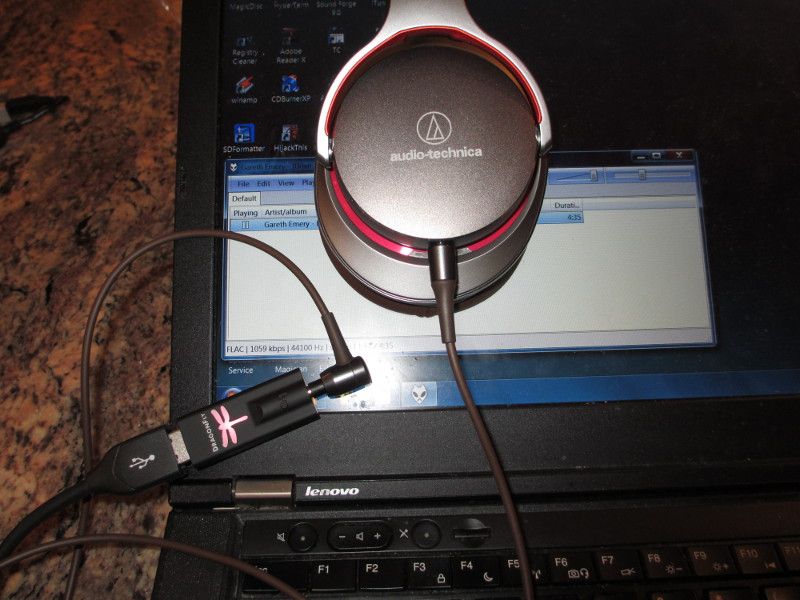
One feature that is not advertised as part of DragonFly spec is their compatibility with smartphones. The original intent of DragonFly design was to provide a pure USB DAC functionality, but with support of OTG USB connectivity offered by so many smartphones - it begs to give it a try, which is exactly what I did with my Galaxy Note 4. There are a lot of variables in this equitation, depending on DAC and power requirements of DragonFly as well as OTG USB support of your phone, and eventually I was able to get it to work but only while using USB Audio Player Pro app (free demo available from Google Play). It was truly a joyful moment to get it to work with my phone, but results will vary (and might not always work) with different phones and Android OS versions. Considering an expected improved support of USB Audio with the latest Android 5.x (Lollipop), I'm looking forward to test it again once the official updates start to roll out for Note 4 on Verizon (I prefer to stay stock, rather than rooted). But in general, OTG USB feature is not fully supported by DragonFly v1.2.
With Note 4.
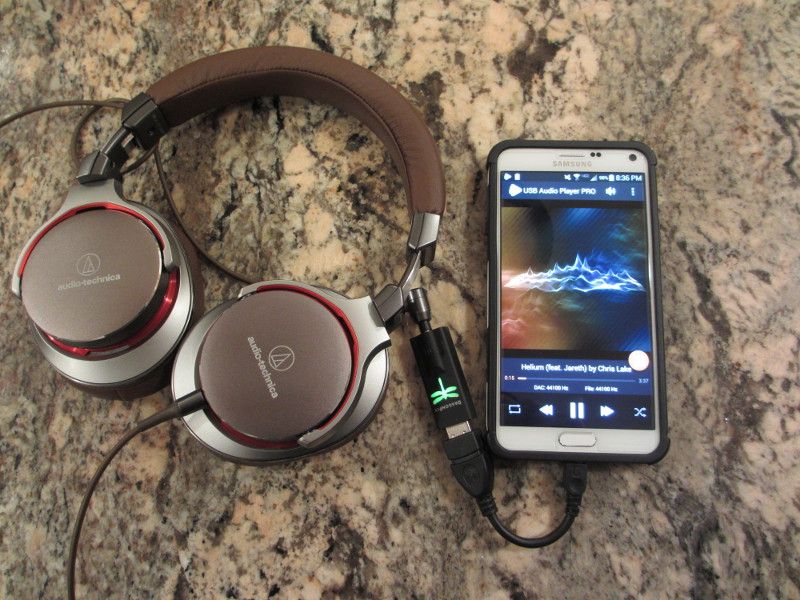
After this introduction of design features and functionality, the only remaining question is how does it sound and if it provides any improvement over the HO of laptop/PC? Without even a slight hesitation in my answer - the sound improvement over my laptop headphone output is definitely noticeable. Everything from an improved texture of the bass to a full body of mids and crispier treble shows a big step up from my stock laptop sound. In more details, bass extends down to a warm texture of sub-bass and adds a more aggressive mid- bass punch to drive low end with more authority. Lower mids get thicker with more body and improvement in tonality, especially making both male and female vocals more organic. Upper mids are clear and detailed, but still smooth and warm. Treble gets a better extension, but remains smooth and not offensive for extended listening. Soundstage gets a little bit more airy with improved depth, definitely above average, while width remains just average. Sound remains smooth and balanced, a little more on a warm side but still with plenty of detail retrieval. It's not exactly bright/analytical, but still very detailed with a nice balance across entire spectrum.
Overall, I really enjoyed DragonFly v1.2 USB DAC and actually found it to pair up nicely with many of my neutral and brighter sound sig IEMs/headphones. As I mentioned in my intro, I had a chance to review quite a few different USB DACs, and in general found some subtle audio differences with sound among them being either relatively brighter or darker/smoother and some variations in a level of soundstage width/depth or the amount of power they can pump out. But often a final decision comes down to a difference in extra features and build/design preferences. Nothing is 100% perfect, but some offer more robust compatibility with smart devices while others more features like dedicated volume knob or gain switch. I can't judge improvement of DragonFly v1.0 vs v1.2 since I never tested the original one, but I can tell you with certainty this latest release from AudioQuest really stands out with a smooth/warm-ish and detailed sound signature and a rather unique design which going to capture attention with its compact footprint and clever sample rate dragonfly led indicator. I also think its build quality and size is perfect for traveling, including that really cool leather storage sleeve. Sound improvement is always subjective when comparing to the original HO of your laptop/PC, and you also have to consider a synergy with your particular set of headphones, but I definitely recommend giving DragonFly USB DAC a try to check it out how it works in your setup!
No matter how much I enjoy listening to music from a portable DAP or a smartphone, laptop is still a very important part of my personal entertainment, and I'm not giving up on it especially since nothing can substitute for me a physical keyboard! Unfortunately, my laptop audio performance is subpar which becomes painfully noticeable whenever I use premium headphones trying to play higher res audio. It's a common problem recognized by a number of manufacturers with their own USB DAC/amp solutions in a form of a small external usb device used like an external audio card. In the past few months I had an opportunity to review a number of such products, but after every review I have been asked to compare it to Dragonfly - a portable device that started its journey almost 3 years ago and paved a way for a lot of other similar products. Now, over a year after their hardware update to v1.2, I got an opportunity to review this friendly insect and would like to share with you about its infectious soundbite!
Starting with a packaging, the first thing you notice is a colorful image of dragonfly on the cover. I typically don’t analyze a product name since often it’s a boring mixture of letters and number, but I actually found it here to be rather unique. Furthermore, I think it was brilliant how their projected this image even further by having a custom shaped “dragonfly” led with changing colors corresponding to a sample rate (more about it later). I found a read around the box to be quite educational to learn about the product description, capabilities and features. Basically, you can familiarize yourself with DragonFly USB DAC even before taking it out.
Out of the box, you will find a dense foam tray with a cutout for the Dragonfly DAC and the included leather case. Typically I would find a case for usb-stick size device to be an add-on filler, but here it looked and felt like a premium accessory which I’m definitely planning to use moving forward with this USB DAC. I know, this is only a small pocket case, but the level of details with a neat stitching around it and stamped dragonfly logo with a model and a company name was very impressive. Plus, it will protect soft touch finish of the DAC when not in use. Another must-have accessory worth mentioning is DragonTail 4” usb extender. This is NOT included with DragonFly and has to be purchased separately, but I really hope that moving forward AudioQuest will consider adding it as a bonus with their DAC (considering competitive pricing of other similar products).
DragonTail is not just an accessory for convenience. DragonFly itself comes with a built-in full size usb connector (covered with protective dust cap) which requires you plugging it into your laptop/PC/Mac, etc. Often due to adjacent usb ports or location on the back, it’s not always convenient to have a device plugged in directly, so extension helps mitigate this problem. At the same time you have to remember that AudioQuest is a well known company that also makes top quality digital and audio cables. A cable is a conductor with multiple wires where a proper isolation of power and data lines while keeping it further away from a noisy motherboard of your laptop will improve signal integrity and EMI interference. The effect could be subtle, but keep in mind there is a good reason why bringing out audio digitally from your laptop to process analog part externally yields cleaner audio signal. Thus, I would strongly recommend getting DragonTail as an accessory to DragonFly. Plus, if not paying attention, it’s easy to disengage DragonFly by accident from your host usb socket if you pull on headphone chord by mistake. With USB extension cable you have more flexibility if you pull on a chord by accident.
Unboxing and accessories.








The first impression you get when holding DragonFly in your hand is how much it resembles an ordinary USB stick. It has very similar dimensions with full size usb connector on one end (and a traditional dust cap), and 3.5mm headphone jack on the other end. The build is very solid and has a little bit of weight to it, definitely feels sturdy. By feeling a slightly colder surface, I'm pretty sure the shell is made out of aluminum or some lightweight alloy, and it has a soft touch rubbery finish similar to ThinkPad laptops (perfect match for me since I only use ThinkPads). Also, right in the middle of the module there is an emblem of a dragonfly with DragonFly name above it. What is really cool, the emblem is a hidden led in a shape of a dragonfly that lights up in different colors to reflect sample rate of your source: 44.1kHz (green), 48kHz (blue), 88.2kHz (amber), 96kHz (magenta).
Design details.






One might wonder, what can you possibly pack inside of such a small footprint? Well, apparently you can stuff it with ESS Sabre DAC, analog volume control (controlled through computer with 60-position resolution), and analog output buffer section. Furthermore, it supports asynchronous Class 1 USB data transfer using some proprietary protocol which enhances performance of digital audio. Personally, I prefer to make my final judgment of a sound quality based on what I hear with my own ears rather than fancy design terminology, but I was still impressed that AudioQuest provided details of the design unlike some other companies that prefer to keep it as a "black box".
Connection to my laptop was flawless, and after initial "pair up" of installing/checking all the necessary Windows drivers, it worked in a true instantaneous plug'n'play fashion with the last volume setting being recalled upon each plug in. I don't have any high impedance headphones to confirm, but with most of my IEMs and headphones I didn't have to raise volume higher than 1/4 of the way, but you can pump it pretty loud with a linear performance and no distortion. One unique feature of DragonFly is that you can enjoy variable volume output while adjusting the level through your audio player and/or computer system. But once you set the output of both audio player and computer to a maximum level, you can feed it directly to external portable amp or desktop preamp/AV receiver. It wasn't clear to me if internal amp gets disabled at maximum volume output, acting like a typical LO, but I assume the intention of that was to avoid double amping.
Connected to laptop.



One feature that is not advertised as part of DragonFly spec is their compatibility with smartphones. The original intent of DragonFly design was to provide a pure USB DAC functionality, but with support of OTG USB connectivity offered by so many smartphones - it begs to give it a try, which is exactly what I did with my Galaxy Note 4. There are a lot of variables in this equitation, depending on DAC and power requirements of DragonFly as well as OTG USB support of your phone, and eventually I was able to get it to work but only while using USB Audio Player Pro app (free demo available from Google Play). It was truly a joyful moment to get it to work with my phone, but results will vary (and might not always work) with different phones and Android OS versions. Considering an expected improved support of USB Audio with the latest Android 5.x (Lollipop), I'm looking forward to test it again once the official updates start to roll out for Note 4 on Verizon (I prefer to stay stock, rather than rooted). But in general, OTG USB feature is not fully supported by DragonFly v1.2.
With Note 4.

After this introduction of design features and functionality, the only remaining question is how does it sound and if it provides any improvement over the HO of laptop/PC? Without even a slight hesitation in my answer - the sound improvement over my laptop headphone output is definitely noticeable. Everything from an improved texture of the bass to a full body of mids and crispier treble shows a big step up from my stock laptop sound. In more details, bass extends down to a warm texture of sub-bass and adds a more aggressive mid- bass punch to drive low end with more authority. Lower mids get thicker with more body and improvement in tonality, especially making both male and female vocals more organic. Upper mids are clear and detailed, but still smooth and warm. Treble gets a better extension, but remains smooth and not offensive for extended listening. Soundstage gets a little bit more airy with improved depth, definitely above average, while width remains just average. Sound remains smooth and balanced, a little more on a warm side but still with plenty of detail retrieval. It's not exactly bright/analytical, but still very detailed with a nice balance across entire spectrum.
Overall, I really enjoyed DragonFly v1.2 USB DAC and actually found it to pair up nicely with many of my neutral and brighter sound sig IEMs/headphones. As I mentioned in my intro, I had a chance to review quite a few different USB DACs, and in general found some subtle audio differences with sound among them being either relatively brighter or darker/smoother and some variations in a level of soundstage width/depth or the amount of power they can pump out. But often a final decision comes down to a difference in extra features and build/design preferences. Nothing is 100% perfect, but some offer more robust compatibility with smart devices while others more features like dedicated volume knob or gain switch. I can't judge improvement of DragonFly v1.0 vs v1.2 since I never tested the original one, but I can tell you with certainty this latest release from AudioQuest really stands out with a smooth/warm-ish and detailed sound signature and a rather unique design which going to capture attention with its compact footprint and clever sample rate dragonfly led indicator. I also think its build quality and size is perfect for traveling, including that really cool leather storage sleeve. Sound improvement is always subjective when comparing to the original HO of your laptop/PC, and you also have to consider a synergy with your particular set of headphones, but I definitely recommend giving DragonFly USB DAC a try to check it out how it works in your setup!
